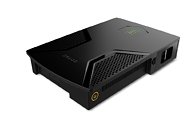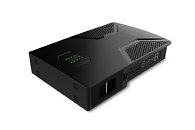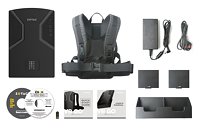Thursday, December 1st 2016

ZOTAC VR Go Backpack With Core i7 6700T and GTX 1070 Priced: $1999
After announcing earlier this week the impending release of their VR Go backpack, ZOTAC has now made pricing details available: $1999 will net you the ability to strap a PC to your body so you can freely engage with enemies or friends alike in VR environments.
The ZOTAC VR GO can work autonomously for up to two hours, feeding on two Li-ion batteries rated at 95Wh (6600mAh). The batteries can be hot-swapped and charged separately, featuring a DC12V-out for powering the HTC Vive or Oculus Rift. When not in use as a backpack to play virtual reality games, the VR GO can be used like a normal desktop computer: its form-factor allows it to be placed on a desk either vertically or horizontally and all the ports will remain accessible. It isn't very heavy, either, though at 4.95 kilograms, your mileage may vary.For that price, you get a pretty high-specced PC with Windows 10 Home pre-installed, sporting an Intel Core i7 6700T (2.8 GHz base, up to 3.6 GHz turbo), the mentioned NVIDIA GTX 1070, 16 GB of DDR4-2133 memory installed (upgradable up to 64 GB), a 240 GB M.2 SATA SSD (with one extra, unpopulated 2.5" SATA bay) and a 3-in-1 card reader (SD/SDHC/SDXC), with the hardware being both passively (with heatsinks) and actively (with fans) cooled for your bodily (and hardware) comfort.
With regards to I/O, you have your usual headphone and microphone ports, as well as 6x USB 3.0 ports, dual Gigabit LAN (powered by Realtek), Wi-Fi 802.11ac/b/g/n as well as Bluetooth on the 4.2 protocol. The GTX 1070 powering it means you can use up to four displays (should you choose to use your backpack-PC as a desktop-PC), with the VR Go sporting 3x HDMI 2.0 (needed for your VR enabler of choice) as well as 2x DisplayPort 1.3 ports.
The ZOTAC VR GO can work autonomously for up to two hours, feeding on two Li-ion batteries rated at 95Wh (6600mAh). The batteries can be hot-swapped and charged separately, featuring a DC12V-out for powering the HTC Vive or Oculus Rift. When not in use as a backpack to play virtual reality games, the VR GO can be used like a normal desktop computer: its form-factor allows it to be placed on a desk either vertically or horizontally and all the ports will remain accessible. It isn't very heavy, either, though at 4.95 kilograms, your mileage may vary.For that price, you get a pretty high-specced PC with Windows 10 Home pre-installed, sporting an Intel Core i7 6700T (2.8 GHz base, up to 3.6 GHz turbo), the mentioned NVIDIA GTX 1070, 16 GB of DDR4-2133 memory installed (upgradable up to 64 GB), a 240 GB M.2 SATA SSD (with one extra, unpopulated 2.5" SATA bay) and a 3-in-1 card reader (SD/SDHC/SDXC), with the hardware being both passively (with heatsinks) and actively (with fans) cooled for your bodily (and hardware) comfort.
With regards to I/O, you have your usual headphone and microphone ports, as well as 6x USB 3.0 ports, dual Gigabit LAN (powered by Realtek), Wi-Fi 802.11ac/b/g/n as well as Bluetooth on the 4.2 protocol. The GTX 1070 powering it means you can use up to four displays (should you choose to use your backpack-PC as a desktop-PC), with the VR Go sporting 3x HDMI 2.0 (needed for your VR enabler of choice) as well as 2x DisplayPort 1.3 ports.




17 Comments on ZOTAC VR Go Backpack With Core i7 6700T and GTX 1070 Priced: $1999
Not that I'd ever spend that kinda of cash on a pre-fabbed PC...
what a ripoff
"This gaming laptop is
2K yet doesn't actually include VR headset
what a ripoff"
"This 1070 portable gaming machine is
2K yet doesn't actually include VR headset
what a ripoff"
It's a portable rig you wear on your back that has a full blown i7 6700T (303$ per recommended customer price), a full blown 1070 that somehow fits in that small chassis (1070m's go for 900$, 1070 mini itx go for 400$ so likely somewhere in between) Mini ITX mainboard 100-150$, integrated mini power supply with enough juice to handle said 1070 and i7, 150-200$, 16GB ddr4 80-100$, 240GB M.2 SSD 80-100$, 2 hour battery 150-200$, Windows 10 100-150$, the case 50-100$, the backpack 20-50$, etc...
1500-1800 throw in VR and Zotac branding and the price is not all that crazy.
Also the MSI variant only has a 1060 and a slower cpu and still costs 1999$
Just Saying.
There is no reason why a wireless solution cant be used. If that has to come in the form of a dedicated radio transmitter until consumer wifi products can handle both bandwidth but more specifically latency, then so be it.
I dont know the details of some of the add on wireless options that 3rd parties are trying to sell. I dont want to spend any more on my VR setup atm. Its been fun, but it does feel very Gen1. While there are some titles I am looking forward to (even with Gen1 hardware), like Budget Cuts, I want a res bump and wireless before I really spend much more time in VR.
Or do you have any pics from the inside?
It's harder to find replacement MXM cards, and they're also more expensive.
Granted it has been proven to be barely if at all slower than the itx counterpart and it uses significantly less power, so perhaps it is better overall.
It lacks some of the pros of both desktops and laptops.
It's not a desktop: you can't upgrade the components easily.
It's not a laptop: you can't use everywhere as it is, besides VR.
I still prefer a gaming laptop with a custom backpack and extra batteries, it would be a much more versatile product.
Still haven't seen any arguments against such solution.
Similar cpu, gpu, memory, etc, but a few hundred cheaper (leaving room for a decent backpack and several batteries) while still having its own display and built in mouse and keyboard. Overall you would be correct that would be a better bargain.
A Acer Predator with an i7-6700HQ and a GTX 1070 mobile (more cuda cores, slightly lower clocks) costs 1750 euro - and it's a 17" gaming laptop! Don't like acer? An Asus ROG G752 with a GTX 1070 costs about 1900 euro here - still cheaper then what zotac is asking for what essentially is an easy to carry desktop...
Now tell me... why would anyone buy this thing over a gaming laptop with the similar specs witch is actually cheaper?